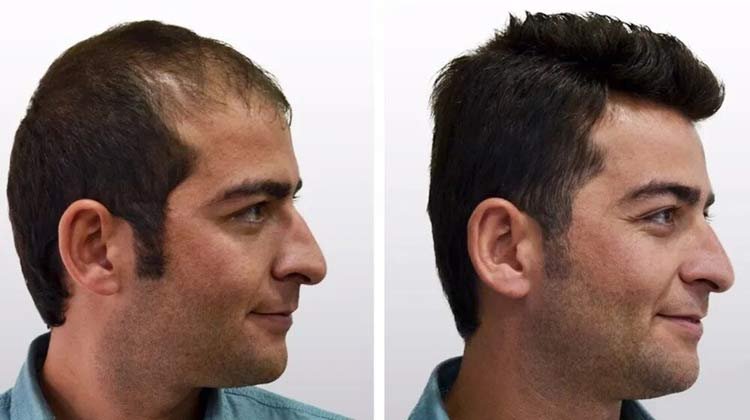Hair loss can be stressful, but the good news is that you have options. Whether you’re looking for permanent results or a temporary solution, both surgical and non-surgical hair transplants offer effective ways to restore your hair and confidence. In this guide, we break down the differences, benefits, risks, and costs of both approaches to help you make an informed decision.
What Is a Surgical Hair Transplant?
A surgical hair transplant involves the extraction of hair follicles from one part of the body (usually the back of the scalp) and implanting them in balding areas. It is a permanent solution for hair loss.
Types of Surgical Hair Transplant:
- FUE (Follicular Unit Extraction): Individual follicles are removed and implanted. Less scarring, quicker recovery.
- FUT (Follicular Unit Transplantation): A strip of scalp is removed, follicles are harvested, and implanted. Leaves a linear scar.
Pros:
- Permanent results
- Natural hair growth
- Low maintenance after healing
- High success rate
Cons:
- Requires downtime
- Costlier than non-surgical options
- Minor scarring (especially in FUT)
- Not suitable for complete baldness
Read – Pros and Cons of Hair Transplant Surgery
What Is a Non-Surgical Hair Transplant?
Non-surgical hair restoration doesn’t involve surgery or incisions. Instead, it includes treatments and hair replacement systems that mimic natural hair or stimulate growth.
Common Non-Surgical Methods:
- Hair Patches or Hair Systems: Custom-fitted wigs or toupees that blend with your hairline
- PRP Therapy (Platelet-Rich Plasma): Stimulates hair growth using your blood’s growth factors
- Hair Fibers and Concealers: Cosmetic solutions for instant volume
- Medications (Minoxidil, Finasteride): Slows down hair loss and stimulates regrowth
Pros:
- No surgery or downtime
- More affordable
- Instant results (in some cases)
- Great for people not eligible for surgery
Cons:
- Temporary or cosmetic
- Regular maintenance required
- Not a cure for baldness
- Some options may look unnatural if not done professionally
Surgical vs. Non-Surgical Hair Transplant: Quick Comparison
| Feature | Surgical Hair Transplant | Non-Surgical Hair Transplant |
| Invasiveness | Invasive (requires surgery) | Non-invasive |
| Downtime | 7–14 days | Minimal to none |
| Cost Range (India) | ₹40,000 – ₹1,50,000+ | ₹2,000 – ₹50,000+ |
| Duration of Results | Permanent | Temporary or semi-permanent |
| Suitability | Ideal for patterned baldness | Great for all types |
| Maintenance | Minimal | Regular upkeep needed |
| Scarring | Possible (FUT) or minimal (FUE) | None |
Who Should Choose Surgical Hair Transplant?
- Men with male pattern baldness
- People looking for a long-term solution
- Individuals with good donor hair
- Those ready for a one-time investment
Who Should Choose Non-Surgical Hair Transplant?
- People who want instant results
- Individuals with limited donor hair
- Those who avoid surgery
- Budget-conscious individuals
Hair Transplant Cost in India (2025 Updated)
Surgical Hair Transplant Cost:
- FUE Method: ₹50,000 – ₹1,50,000+
- FUT Method: ₹40,000 – ₹1,20,000+
Non-Surgical Hair Restoration Cost:
- Hair Patch / System: ₹5,000 – ₹40,000+
- PRP Therapy: ₹4,000 – ₹15,000 per session
- Hair Fibers / Concealers: ₹500 – ₹3,000
- Medications: ₹500 – ₹2,000/month
Final Thoughts: Which One Is Right for You?
Both surgical and non-surgical hair transplant options have their place. If you’re looking for permanent, natural-looking hair growth, surgical methods like FUE or FUT are ideal. But if you want non-invasive, affordable, and quick fixes, non-surgical alternatives like hair patches or PRP can deliver excellent results.
Before making a decision, consult with a certified hair restoration specialist to understand your hair type, scalp condition, and expectations
FAQs:
Q1. Is a surgical hair transplant painful?
A: It’s performed under local anesthesia. Some discomfort is normal post-procedure but manageable.
Q2. How long do non-surgical hair systems last?
A: Hair patches or systems typically last 6 months to 1 year with proper care.
Q3. Can I switch from non-surgical to surgical later?
A: Yes, many individuals start with non-surgical solutions before opting for a permanent transplant.
Q4. Which is more cost-effective long term?
A: While surgical transplants have a higher upfront cost, they’re more cost-effective over time.






